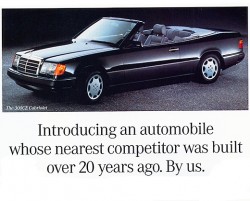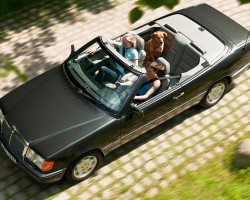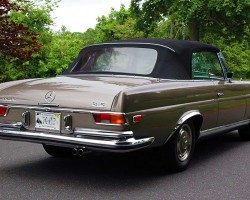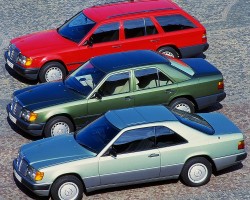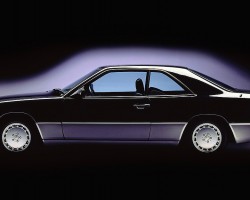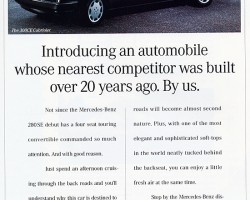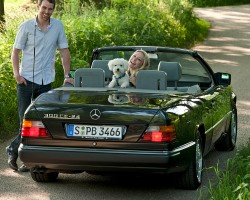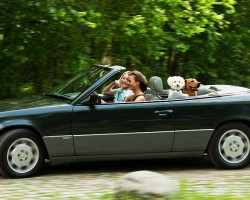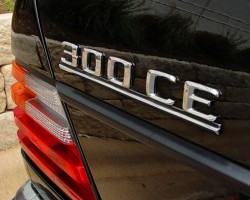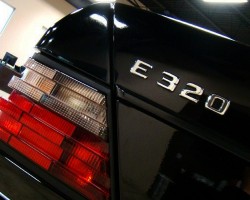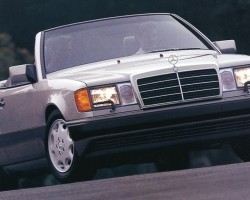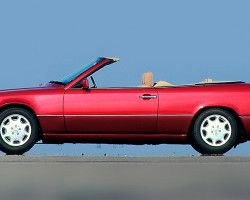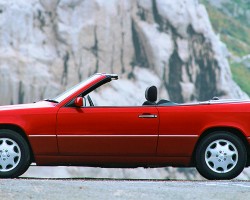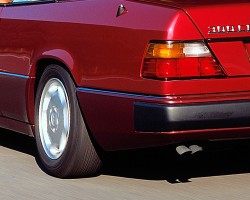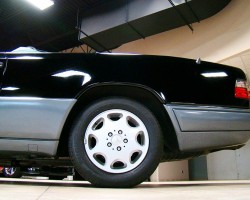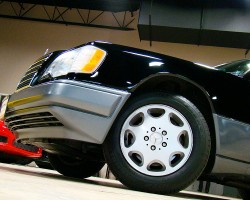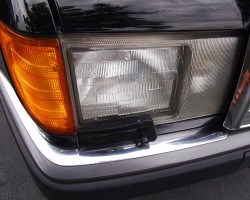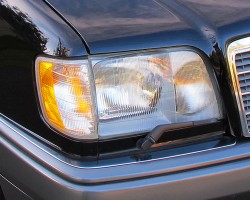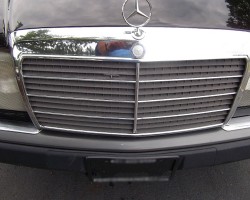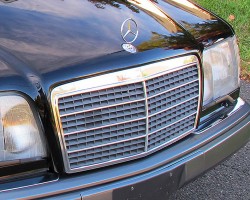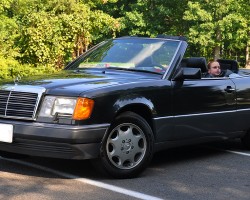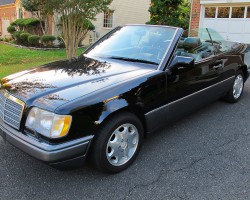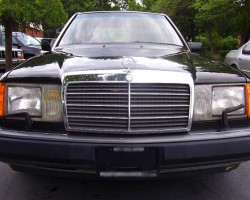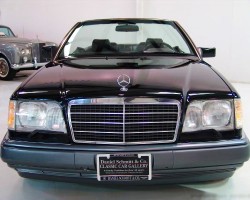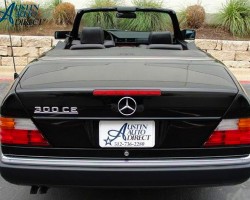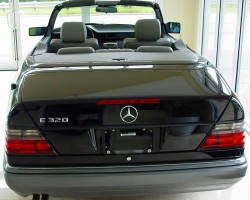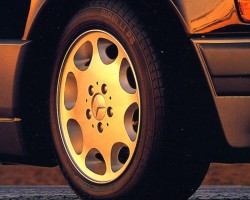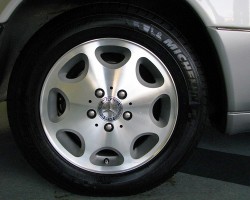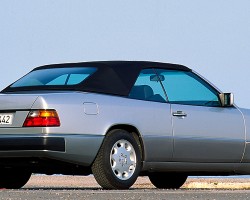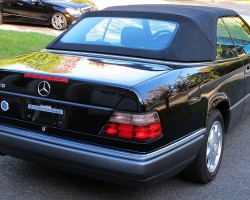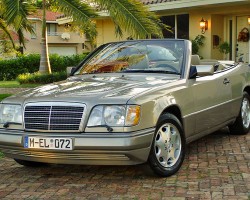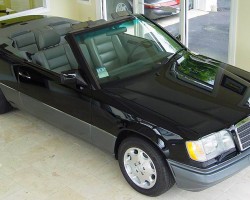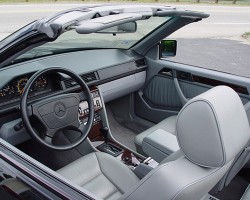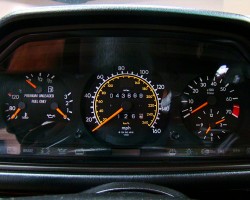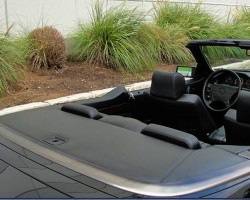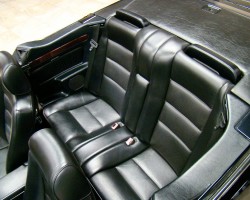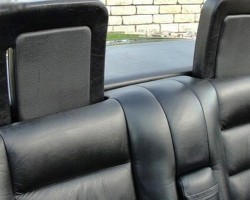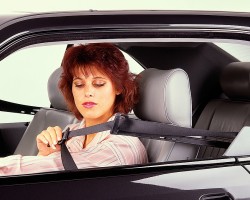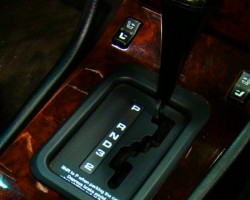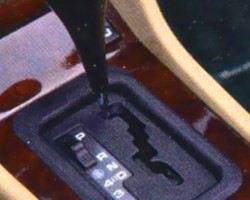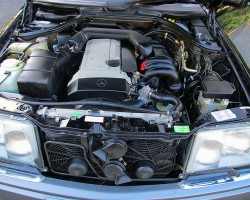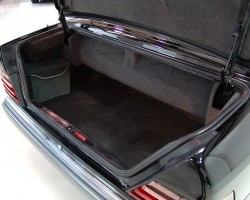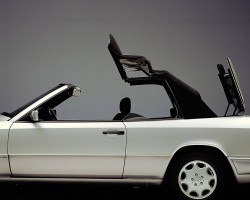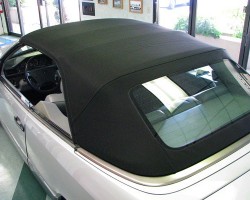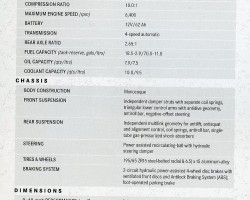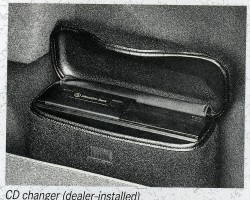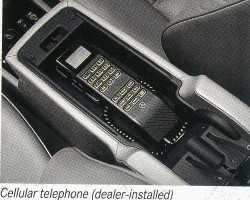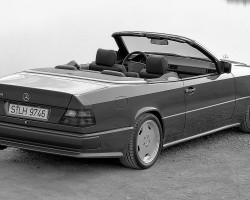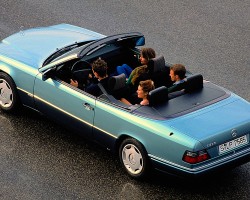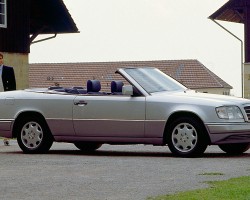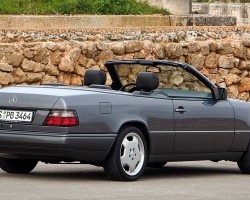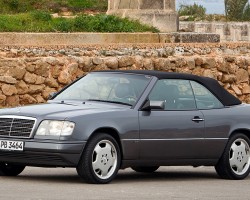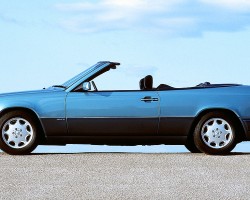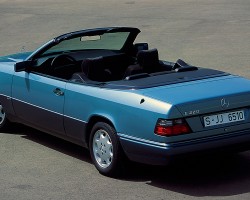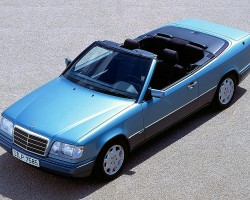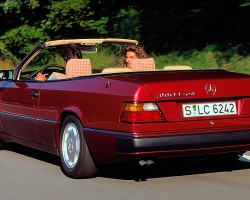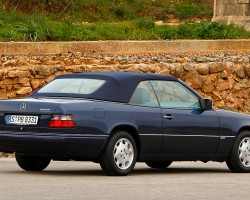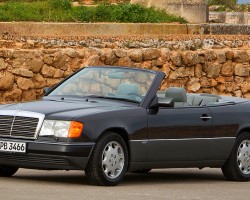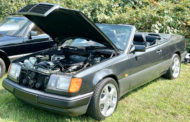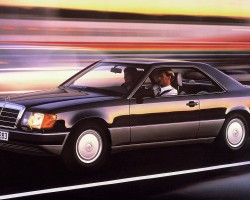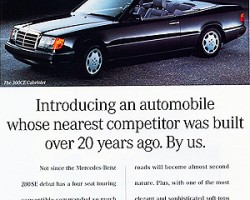“Few automobiles can claim to be instant classics. The thrilling new 300CE Cabriolet might be one of them” claimed advertising introducing the 1993 E-class Cabrio to the United States market. Truer words have never been spoken if one considers how much owners covet them and the prices buyers are willing to pay decades later today.
(A slideshow showing all variations of E-class Cabriolets is at the end of this article)
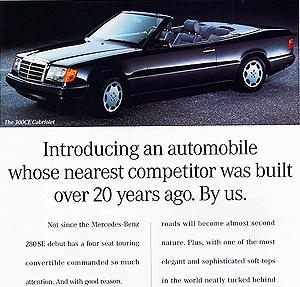
Returning after a 20-year hiatus: The 4-passenger Mercedes convertible. (Photo credit: Mercedes-Benz North America)
Lacking a four-passenger convertible since the last 1971 280SE model was produced, Mercedes began developing such prototypes based on the hardtop coupe version of the company’s midsize “124 body” platform during 1990. 124 body models had been introduced in sedan form for 1986 (300E), wagon form for 1987 (300TE), and coupe form for 1988(300CE).
Engineering on the new convertible was completed during early 1991, allowing it to make its official world debut at that year’s Frankfurt Auto Show. Factory production of the first 124 body Cabriolets officially began December 1991 and European markets received the first Cabrios built as 1992 models. Since introduction of the Cabrio in the United States was pushed back later into the 1992 calendar year, U.S. versions were first available as 1993 models.
MODEL YEARS CABRIOLETS WERE AVAILABLE
In the United States: 1993 – 1995.
In Europe and Asia: 1992 – 1997 (varied greatly based on market)
Floors, transmission tunnels, windshield frames, door frames, even the convertible top storage compartments were engineered to provide extra body rigidity lost by convertibles. Engineers did their homework thoroughly, as all automotive reviewers gave the 300CE Cabrio high marks for no cowl shake, creaks, or flexing over bumps. Like the 300CE coupe, 8-hole style wheels were standard on all Cabrios upon introduction.
ENGINES POWERING CABRIOLETS
3.0-liter inline 6-cylinder (1992) : The first Cabrios, built as 1992 models for sale in Europe, were badged as “300CE – 24” Cabriolets. The 24 nomenclature referred to the 24-valve cylinder head version of the 3.0-liter inline 6-cylinder engine used (on two-door 124 bodies only) since 1990. Horsepower was 217 and torque was 195 foot-pounds.
3.2-liter inline 6-cylinder (1993-1995/97) : For 1993, the 3.0-liter was enlarged to 3.2 liters on all 124 body models, and retained 24-valve cylinder heads for better air intake. While the increase in engine displacement did not change the horsepower rating (still at 217 hp), torque jumped from 195 to 229 foot-pounds…enough to make a noticeable different in low end grunt off the line. For the 1993 model year, this model was still badged the “300CE” in the U.S. but was known as the “320CE ” in Europe and Japan. For 1994-on, all models with this engine became known as “E320” Cabriolets.
2.2-liter inline 4-cylinder (1993-97) : A 220CE / E220 Cabrio model was sold in Europe and other markets during the 1993-97 model years, and featured an engine producing 150 horsepower. This was never brought to the U.S.
2.0-liter inline 4-cylinder (1993-97) : Similar to the 2.2-liter model above, a 200CE / E200 Cabrio was marketed during 1993-97 in Europe only.
1994: A NEW FACE AND A NEW NAME (SEE SLIDESHOW FOR PICTORAL DETAILS)
A second design update to all 124-body models caught fans of the marque off guard. Mercedes had already given 124 body sedans and wagons a traditional mid-life style update four years earlier for 1990. And even mid-life style updates were somewhat new to this car company that sometimes was known for leaving various models in production eighteen years without one body panel changing.
Larger, one-piece headlights that were consistent in design with the new 1992 S-class sedans and 1994 C-class replaced the square-in-rectangle headlights that dated back to 1986. A new grille was integrated into a slightly revised hood that wrapped around it, rather than being bolted on to the end of the hood. (See slide show for examples). Finally, European and U.S. models looked the same.
To avoid confusion that had grown from number-based model badges sounding too similar (for example: the 300E, 300CE, 300SL, and 300SE actually represented vastly different offerings in the lineup), Mercedes marketers created a more uniform badging system.
All 124-body models would now be known as the “E-class” and would have an E followed by number reflecting engine size accurately. Additional letters such as T and C that had designated wagon and coupe bodies were gone. Suffixes that existed to reflect an engine larger or smaller in size than the model number (ex: 300E 2.6) were no longer needed. Thus, all 124 body ragtops were renamed E320 Cabriolets through the remainder of their production run.
DIFFERENCES BETWEEN EUROPEAN AND U.S. CABRIOS
While 124-body Cabriolets were introduced early in 1992, they were sold as ’92 models in other parts of the world before being introduced later that year in the U.S. as ’93 300CE models. Early Cabrios were badged as the 1992 “300CE-24” through Europe, and as the “320CE” in Japan and England.
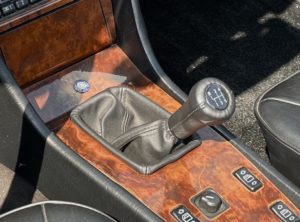
While all U.S. versions were equipped with 4-speed automatic transmissions, 124-body Cabrios sold in other markets were equipped with either Mercedes-Benz’s new 5-speed automatic transmission or a 5-speed manual.
For 1994, Cabrios in all markets including the U.S. uniformly became the “E320 Cabrio”. Even headlight assemblies which had previously differed from region to region were now the same worldwide.
While all U.S. versions were equipped with 4-speed automatic transmissions, 124-body Cabrios sold in other markets were equipped with either Mercedes-Benz’s new 5-speed automatic transmission or a 5-speed manual.
It’s interesting to note that even though the last year for 124-body convertibles in the United States and most of the world was 1995, they remained for sale through the ’97 model year in some European markets.
CLICK ON ANY OF THE PICTURES IN THE SLIDE SHOW BELOW TO EXPAND TO FULL SIZE. USE ARROWS UNDERNEATH PICTURES TO SCROLL BACKWARD OR FORWARD.
- An advertisement introducing the 1993 Mercedes 300CE Cabriolet to the United States. The car shown in the ad is actually a Euro model (notice the flush headlamps U.S. models didn’t get).
- A European market promotional photo introducing the 124 body Cabriolet for the 1992 model year, one year earlier than in the United States. Cabrios were sold through the 1995 model year in the U.S., and through 1997 in parts of Europe.
- The 1971 280SE Convertible was the last four-seat Mercedes ragtop produced until the 300CE Cabrio was introduced twenty years later.
- The Mercedes midsize platform that spawned the 300CE/E320 Cabriolets is referred to as the 124-body. Shown in this 1988 photo are other 124 variations: 300CE coupe (foreground, 1988-95), 300E sedan (middle, 1986-95), and 300TE wagon (rear, 1987-95). Photo credit: Mercedes-Benz Classic Center
- A closer look at the hardtop coupe version of the 300CE, introduced years earlier as a 1988 model.
- An advertisement introducing the 1993 Mercedes 300CE Cabriolet to the United States. The car shown in the ad is actually a Euro model (notice the flush headlamps U.S. models didn’t get). Photo credit: Mercedes-Benz of North America
- 1992 Euro models were introduced as the “300CE-24” reflecting the 24-valve 3.0-liter engine fitted that year only. For 1993, the 3.0-liter was enlarged to 3.2 liters. Although U.S. and Euro markets both got the 3.2, ’93s were badged “320CE” in Europe and “300CE” in the U.S.
- (1992 MERCEDES 300CE Cabrio) Early Euro-market Cabrio models such as this one were equipped with slightly different wheels that did not see production on U.S. versions.
- For the 1993 model year only, 124-body convertibles were badged as the 300CE Cabriolet in the U.S. (Photo credit: M. Garcia)
- For the 1994-95 models years in the U.S., 124-body convertibles were known as E320 Cabriolets. This reflected the new corporate way of naming models (with letters first) which began across the entire product line for 1994. (Photo credit: T. Mahajan)
- Promotional photo introducing the U.S. market 1993 300CE Cabrio. Notice the “square within rectangle” headlight assemblies unique to the U.S. market. Headlight wipers were standard equipment.
- The side view of this 1993 300CE Cabriolet illustrates how bumper rub strips front and rear were highlighted in black on all E-class model variations through 1993. (Photo credit: Mercedes-Benz Classic Center)
- For 1994, rub strips on front and rear bumper covers were matched to the rest of the bumper instead of being highlighted in black (see prior photo). 1994 model shown. Photo credit: Mercedes-Benz Classic Center
- A closer look at the rear bumper rub strips, painted black on all colors of 1993 models. (Photo credit: Mercedes-Benz Classic Center)
- A closeup view of 1994-95 style rear bumper covers (1994 model shown). While rub strips previously ended shortly after the corner of the bumper, they now extended almost the entire way towards the rear wheel. (Photo credit: L. Plugg)
- A closer view of the 1994-95 front bumper cover assembly. Most bumper covers and side plastic cladding were color matched to the vehicle. However, models painted black, silver, dark gray, and white featured gunmetal gray lower cladding as a contrast. (Photo credit: L. Plugg)
- A closer view of a U.S. market 1993 300CE headlight assembly. Like all 124-body E class models from 1986-93, headlights were separate, semi-flush square units inset into a surrounding plastic bezel. (Photo credit: Nate Smith)
- 124-body cabrios from 1994 on feature redesigned one-piece headlamp assemblies, curved at the inner top corner in the style of S-class ones. (Photo credit: W. Palamara)
- The 300CE of 1993 was the last year for traditional Mercedes grilles (with attached hood ornament) that bolted on to the end of the hood. (Photo credit: W. Palamara)
- For 1994-1995, hood ornaments were no longer attached the grille, but to the hood itself. The black painted parts surrounding the redesigned grille visible in this picture are actually part of the restyled hood (1995 model shown). Credit: M. Johannsen
- A front 3/4s view of a U.S. market 1993 300CE Cabriolet. (Photo credit: totallythatstupid.com)
- Front 3/4s view of an E320 Cabriolet (1995 model shown)This picture allows a look at the front end design updates on 1994-on models. Photo credit: M. Johannsen
- A wider view of a U.S. market 1993 300CE Cabriolet. (Photo credit: W. Palamara)
- The updated front end of 1994 – later E320 Cabriolets. 1995 U.S. model shown. (Photo credit: Schmitt Motorcars)
- Rear view of a 1993 300CE Cabrio. Notice turn signal lenses on the rear taillamp assemblies are amber colored here – the following year, these sections would be clear (see next photo). Photo credit: Austin Auto Direct
- For 1994, very little changed on the rear. Turn signal sections were now clear instead of amber colored, and bumper rub strips were now matched to the bumper paint color instead of black (see previous photo). Photo credit: R. Green
- These eight-hole 15-inch aluminum wheels were standard on all 124 body cabriolets from 1993-on. In keeping with decades of tradition, the aluminum wheels were painted silver as shown in this 1993 U.S. market brochure picture. (Photo credit: Mercedes Benz USA)
- Alloy wheels on 1994-on E-class models were the same design as the prior year, but were no longer painted. The aluminum facing on the wheels was now brushed instead (1995 E320 Cabrio shown). Photo credit: S. Solominski
- A rear 3/4s top-up view of an “early” 124 body cabriolet. This promotional photo introduces the European market 1992 300CE-24 Cabriolet.
- For comparison, a rear 3/4s top-up view of a “later” 124 body Cabrio. 1995 model shown. (Photo credit: M. Johannsen)
- Most colors of 124-body Cabriolets featured bumper covers and lower plastic body cladding that was 90% color matched to the paint color itself, as on this 1995 E320 Cabrio. (Photo credit: C. Schwartz)
- A U.S. market 1995 E320 Cabriolet. (S. Dombroski)
- Interior view of a U.S. market 1995 E320 Cabrio (interiors remained unchanged during the production run). Photo credit: K. Gamborelli
- A view of the 1993-1995 style instrument cluster, which remained unchanged during the three year cabrio production run in the United States. (Photo credit: J. Ira)
- A view of the tonneau cover which folded up to allow convertible top up-and-down operation. When the top was stationary (either in the open or closed position), the tonneau cover came to rest in this horizontal position as an aesthetic covering. (Photo credit: Austin Auto Direct)
- Rear seats were unchanged on all year 124 body Cabriolets. (Photo credit: A. Schneider)
- A safety feature on all 124-body convertibles was pop-up rear headrests. In the event of a vehicle rollover, they automatically deploy in less than a second to support the weight of the car. They can be raised by driver control as well. (Photo credit: Austin Auto Direct)
- All 124-body Cabriolets were equipped with seat belt “presenters” which automatically extended when the ignition was turned on. (Photo credit: Mercedes-Benz Classic)
- 1993-95 U.S. model Cabrios were all equipped with 4-speed automatic transmissions. (Photo credit: P. Morris)
- Unlike U.S. models, European-spec 124 cabriolets were fitted with 5-speed automatic transmissions such as this 1993 U.K. market 320CE. A 5-speed manual transmission was available also in Europe, but not in the U.S. (Photo credit: M. Potter)
- The sole engine equipped on all 124-body Cabriolets sold in the United States was the 3.2-liter inline six cylinder engine. This engine was new for 1993, and featured dual overhead camshafts to create 217 horsepower. (Photo credit: F. Schroeder)
- Trunk compartments were the same on all 124-body cabrios. A tool kit and leather owner manual pouch came standard with the car. (Photo credit: L. Plugg)
- A factory promotional photo illustrates the power top operation. The tonneau cover raises and lowers automatically while the top is in motion. (Photo credit: Mercedes-Benz Classic Center)
- Most 124-body Cabrios were equipped with black soft tops, as shown here on this 1994 U.S. model. (Photo credit: V. McCarthy)
- Specifications page as printed in the original 1993 U.S. market 300CE Cabrio brochure. (Photo credit: Daimler A.G.)
- All 124-body Cabriolets were pre-wired for compact disc changers. If the option was ordered, the c.d. changer unit itself was mounted in the trunk. (Photo credit: Mercedes-Benz USA)
- An original U.S. market brochure picture of the optional dealer-installed cellular telephone, which mounted inside the front center armrest. (Photo credit: Mercedes-Benz USA)
- A euro-model 1993 300CE Cabriolet equipped with the AMG upgrade package. 1994 and later models were known as the “E36”, reflecting the enlarged 3.6-liter engine. (Photo credit: Mercedes-Benz Classic Center)
- A factory promotional picture for the lowest-priced 124 body Cabrio sold in Europe, powered by a 2.0-liter 4-cylinder engine. It was badged the 200CE for 1993 and E200 from 1994-on. Notice this low cost model came standard with steel wheels and plastic wheel covers as shown here. (Photo credit: Mercedes-Benz Classic Center)
- Alternate view of a 1994 Mercedes E200 Cabriolet. (Photo credit: Mercedes-Benz Classic)
- Also introduced for 1993 was a Cabrio model powered by a slightly larger 2.2-liter 4-cylinder. Here, a 1995 E220 Cabriolet is shown with optional sport package wheels. (Photo credit: Mercedes-Benz Classic)
- 1995 Euro model E220 Cabriolet, top up view. (Photo credit: Mercedes-Benz Classic)
- Side view of a Euro market E220 Cabriolet. (Photo credit: Mercedes-Benz Classic)
- Second view of a Euro market E220 Cabriolet. (Photo credit: Mercedes-Benz Classic)
- 1994 Mercedes E220 Cabriolet
- Rear view of a 1992 300CE-24 Cabrio Euro model. While U.S. market versions featured leather interiors as standard, other markets had lower cost cloth interiors as shown here. (Photo credit: Mercedes-Benz Classic)
- Rear 3/4s view of a Euro E320 Cabriolet with matching color body and plastic cladding. (Photo credit: Mercedes-Benz Classic)
- A Euro market 1993 320CE Cabriolet. (Photo credit: Mercedes-Benz Classic)
- This 1993 Mercedes 320CE Cabrio is equipped with a 5-speed manual (see next picture of the interior). The headlights were converted to U.S. market assemblies.
- A close-up interior view of a 5-speed manual-equipped 1993 300CE-24 Cabriolet (prior picture).
- Factory promotional picture of a Euro market 1988 124 body coupe. (Photo credit: Mercedes-Benz Classic)

